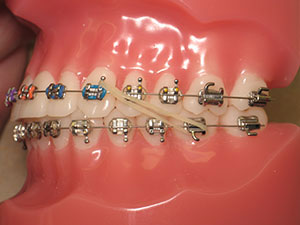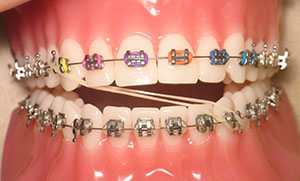
Orthodontics and Elastics
FINE-TUNING YOUR SMILE
Getting braces is an orthodontic treatment that will not only move your teeth along the gumline but will also fix your bite. Moving the upper or lower line of teeth completely requires not only more time but also more force than the braces by themselves can provide; this is where the elastics join the process.
Elastic rubber bands provide the necessary force, over time, to move the lower or upper teeth in the direction needed. Dr. Feller will use braces and elastics in various configurations in order to fix a variety of problems present in someone’s mouth. For the most part, the braces rubber bands deal with different kinds of bad bites, but they are also used to reduce the space between teeth.
Applications For Elastic Wear
THE BEST TOOL FOR THE JOB
Class II Correction
- Purpose: To correct a Class II malocclusion, where the upper teeth protrude over the lower teeth.
- Instructions: Attach elastics from hooks on the upper braces to hooks on the lower braces. Wear elastics as directed by your orthodontist, typically full-time (24 hours a day) except when eating or brushing your teeth.
Class III Correction
- Purpose: To correct a Class III malocclusion, where the lower teeth protrude over the upper teeth.
- Instructions: Attach elastics from hooks on the lower braces to hooks on the upper braces. Wear elastics as directed by your orthodontist, typically full-time (24 hours a day) except when eating or brushing your teeth.
Midline Correction
- Purpose: To correct a midline discrepancy, where the center of the upper and lower dental arches do not align.
- Instructions: Attach elastics from hooks on one side of the upper braces to hooks on the corresponding side of the lower braces. Wear elastics as directed by your orthodontist, typically full-time (24 hours a day) except when eating or brushing your teeth.
Interarch Mechanics
- Purpose: To facilitate specific tooth movements or rotations by applying force between upper and lower teeth.
- Instructions: Attach elastics according to the specific tooth movement prescribed by your orthodontist. Follow instructions for the duration and frequency of elastic wear provided by your orthodontist.
Vertical Control
- Purpose: To control the vertical position of teeth, such as intruding or extruding specific teeth.
- Instructions: Attach elastics from hooks on the upper and lower braces to control the desired vertical movement of teeth. Follow instructions for the duration and frequency of elastic wear provided by your orthodontist.
Open Bite Closure
- Purpose: To close an anterior open bite, where the front teeth do not make contact when biting down.
- Instructions: Attach elastics from hooks on the upper braces to hooks on the lower braces, typically in a diagonal or crisscross configuration. Wear elastics as directed by your orthodontist, typically full-time (24 hours a day) except when eating or brushing your teeth.
Space Closure
- Purpose: To close spaces or gaps between teeth.
- Instructions: Attach elastics from hooks on the upper and lower braces to close the desired spaces. Follow instructions for the duration and frequency of elastic wear provided by your orthodontist.
Instructions for Orthodontic Elastic Wear
GOOD RULES TO FOLLOW
Consistency
Wear elastics consistently. Compliance is crucial for achieving desired treatment outcomes, allowing Dr. Feller’s custom plan to come to fruition.
Change Regularly
Change elastics regularly as instructed by Dr. Feller, typically every 12 hours to maintain optimal force levels.
Proper Placement
Ensure elastics are attached to the designated hooks or attachments on the braces. Follow any specific instructions provided by Dr. Feller or his team for proper placement.
Remove for Eating and Brushing
Remove elastics while eating and brushing your teeth to avoid damage to the braces or elastics.
Wear Full-Time
In most cases, elastics should be worn full time (24 hours a day) except when eating or brushing your teeth. Follow any specific instructions provided by Dr. Feller regarding the duration of elastic wear.
Report Problems
Contact Dr. Feller’s office if you experience any problems or concerns with elastic wear, such as breakage, discomfort, or difficulty attaching elastics.



